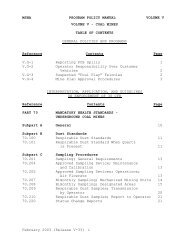MSHA HANDBOOK SERIES - PH13-V-1 - Mine Safety and Health ...
MSHA HANDBOOK SERIES - PH13-V-1 - Mine Safety and Health ...
MSHA HANDBOOK SERIES - PH13-V-1 - Mine Safety and Health ...
You also want an ePaper? Increase the reach of your titles
YUMPU automatically turns print PDFs into web optimized ePapers that Google loves.
GENERAL COAL MINE INSPECTION PROCEDURES AND<br />
INSPECTION TRACKING SYSTEM <strong>HANDBOOK</strong> CHAPTER 5<br />
accumulation. Sampling near advancing mining sections, retreat mining sections,<br />
belt transfers, <strong>and</strong> any other locations where coal dust is generated, or accumulates<br />
should be emphasized. Inspectors should collect enough samples to define problem<br />
areas. When collecting rock dust samples, inspectors should document in their notes<br />
the facts needed to evaluate negligence <strong>and</strong> gravity of potential § 75.403 violations.<br />
Visual confirmation that rock dust has been applied to the non-compliant area(s) may<br />
be used to terminate a violation. However, if fresh rock dust is not evident,<br />
inspectors should resample non-compliant locations before terminating any<br />
enforcement actions. A green reading by <strong>MSHA</strong>s coal dust explosibility meter<br />
(CDEM) may be used for termination of a citation or order.<br />
Guidelines for sample areas, the minimum number of samples <strong>and</strong> the frequency of<br />
sampling are:<br />
Quarterly Sampling<br />
Working Sections<br />
Continuous <strong>Mine</strong>r <strong>and</strong> Conventional Working Sections<br />
Mining coal generates an average of 0.1 pounds of float coal dust per ton of coal<br />
mined according to research published by the U.S. Bureau of <strong>Mine</strong>s. Most of this<br />
float coal dust is deposited at or near the working sections. The likelihood of a<br />
methane ignition is greatest at the working faces due to the confluence of methane<br />
liberation during mining, frictional sparking from the mining process <strong>and</strong><br />
potential permissibility problems. The effective control of coal dust on the<br />
working section is critical to prevent small methane ignitions at or near the<br />
working face from transitioning to a large coal dust explosion.<br />
Inspectors should collect at least four b<strong>and</strong> samples per air course between 40 feet<br />
outby the working faces <strong>and</strong> 1,000 feet outby the working faces. Samples may be<br />
collected from completed (<strong>and</strong> roof-bolted) crosscuts within 40 feet of working<br />
faces. If the section has advanced less than 1,000 feet from the mouth of the<br />
section (where the section has broken off from a main or submain), samples may<br />
be collected from the portion of the main or submain aircourses within 1,000 feet<br />
of the working faces. At least one sample per air course should be collected inby<br />
the section loading point including, air courses separated by temporary<br />
ventilation controls similar to the sampling process of those separated by<br />
permanent ventilation controls. The inspector has the authority to close the<br />
necessary entries to mobile haulage equipment in order to collect the rock dust<br />
samples on a working section.<br />
Release 1 (February 2013) 5-13
















